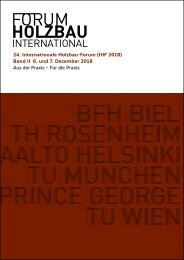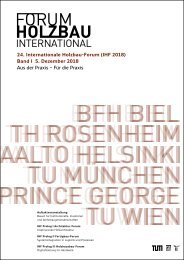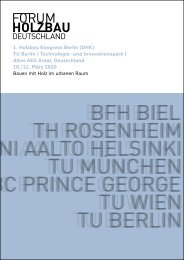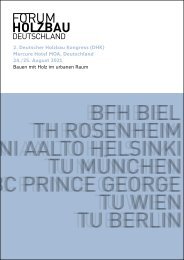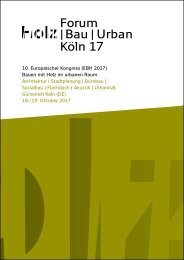- Seite 1 und 2:
10. HolzBauSpezial Kurhaus, Bad Wö
- Seite 3 und 4:
Herausgeber: Bearbeitung und Satz:
- Seite 5 und 6:
10. HolzBauSpezial Bauphysik & Geb
- Seite 7 und 8:
10. HolzBauSpezial Bauphysik & Geb
- Seite 9 und 10:
10. HolzBauSpezial Bauphysik & Geb
- Seite 11 und 12:
10. HolzBauSpezial Bauphysik & Geb
- Seite 13 und 14:
10. HolzBauSpezial Bauphysik & Geb
- Seite 15 und 16:
10. HolzBauSpezial Bauphysik & Geb
- Seite 17 und 18:
10. HolzBauSpezial Bauphysik & Geb
- Seite 19 und 20:
10. HolzBauSpezial Bauphysik & Geb
- Seite 21 und 22:
10. HolzBauSpezial Bauphysik & Geb
- Seite 23:
10. HolzBauSpezial Bauphysik & Geb
- Seite 27 und 28:
10. HolzBauSpezial Bauphysik & Geb
- Seite 29 und 30:
10. HolzBauSpezial Bauphysik & Geb
- Seite 31 und 32:
10. HolzBauSpezial Bauphysik & Geb
- Seite 33 und 34:
10. HolzBauSpezial Bauphysik & Geb
- Seite 35 und 36:
10. HolzBauSpezial Bauphysik & Geb
- Seite 37 und 38:
10. HolzBauSpezial Bauphysik & Geb
- Seite 39 und 40:
10. HolzBauSpezial Bauphysik & Geb
- Seite 41:
10. HolzBauSpezial Bauphysik & Geb
- Seite 44 und 45:
2 10. HolzBauSpezial Bauphysik & Ge
- Seite 46 und 47:
4 10. HolzBauSpezial Bauphysik & Ge
- Seite 48 und 49:
6 10. HolzBauSpezial Bauphysik & Ge
- Seite 50 und 51:
8 10. HolzBauSpezial Bauphysik & Ge
- Seite 52 und 53:
10 10. HolzBauSpezial Bauphysik & G
- Seite 54 und 55:
12 10. HolzBauSpezial Bauphysik & G
- Seite 56 und 57:
14 10. HolzBauSpezial Bauphysik & G
- Seite 59 und 60:
10. HolzBauSpezial Bauphysik & Geb
- Seite 61 und 62:
10. HolzBauSpezial Bauphysik & Geb
- Seite 63 und 64:
10. HolzBauSpezial Bauphysik & Geb
- Seite 65 und 66:
10. HolzBauSpezial Bauphysik & Geb
- Seite 67 und 68:
10. HolzBauSpezial Bauphysik & Geb
- Seite 69 und 70:
10. HolzBauSpezial Bauphysik & Geb
- Seite 71:
Schallschutz und Gebäudehülle - A
- Seite 74 und 75:
2 Schallschutz gegen Aussenlärm be
- Seite 76 und 77:
4 Schallschutz gegen Aussenlärm be
- Seite 78 und 79:
6 Schallschutz gegen Aussenlärm be
- Seite 80 und 81:
8 Schallschutz gegen Aussenlärm be
- Seite 82 und 83:
10 Schallschutz gegen Aussenlärm b
- Seite 84 und 85:
12 Schallschutz gegen Aussenlärm b
- Seite 86 und 87:
2 Direkt- und Flankenschalldämmung
- Seite 88 und 89:
4 Direkt- und Flankenschalldämmung
- Seite 90 und 91:
6 Direkt- und Flankenschalldämmung
- Seite 92 und 93:
8 Direkt- und Flankenschalldämmung
- Seite 94 und 95:
10 Direkt- und Flankenschalldämmun
- Seite 96 und 97:
12 Direkt- und Flankenschalldämmun
- Seite 98 und 99:
14 Direkt- und Flankenschalldämmun
- Seite 100 und 101:
16 Direkt- und Flankenschalldämmun
- Seite 103 und 104:
10. HolzBauSpezial Bauphysik & Geb
- Seite 105 und 106:
10. HolzBauSpezial Bauphysik & Geb
- Seite 107 und 108:
10. HolzBauSpezial Bauphysik & Geb
- Seite 109 und 110:
10. HolzBauSpezial Bauphysik & Geb
- Seite 111 und 112:
10. HolzBauSpezial Bauphysik & Geb
- Seite 113 und 114:
10. HolzBauSpezial Bauphysik & Geb
- Seite 115:
Bauteile - Schalltechnisches Detail
- Seite 118 und 119:
2 10. HolzBauSpezial Bauphysik & Ge
- Seite 120 und 121:
4 10. HolzBauSpezial Bauphysik & Ge
- Seite 122 und 123:
6 10. HolzBauSpezial Bauphysik & Ge
- Seite 124 und 125:
8 10. HolzBauSpezial Bauphysik & Ge
- Seite 127 und 128:
10. HolzBauSpezial Bauphysik & Geb
- Seite 129 und 130:
10. HolzBauSpezial Bauphysik & Geb
- Seite 131 und 132:
10. HolzBauSpezial Bauphysik & Geb
- Seite 133 und 134:
10. HolzBauSpezial Bauphysik & Geb
- Seite 135:
10. HolzBauSpezial Bauphysik & Geb
- Seite 138 und 139:
2 Leichtbautreppen - Probleme und L
- Seite 140 und 141:
4 Leichtbautreppen - Probleme und L
- Seite 142 und 143:
6 Leichtbautreppen - Probleme und L
- Seite 144 und 145:
8 Leichtbautreppen - Probleme und L
- Seite 146 und 147:
10 Leichtbautreppen - Probleme und
- Seite 148 und 149:
12 Leichtbautreppen - Probleme und
- Seite 151 und 152:
10. HolzBauSpezial Bauphysik & Geb
- Seite 153 und 154:
10. HolzBauSpezial Bauphysik & Geb
- Seite 155 und 156:
10. HolzBauSpezial Bauphysik & Geb
- Seite 157 und 158:
10. HolzBauSpezial Bauphysik & Geb
- Seite 159 und 160:
10. HolzBauSpezial Bauphysik & Geb
- Seite 161 und 162:
10. HolzBauSpezial Bauphysik & Geb
- Seite 163 und 164:
10. HolzBauSpezial Bauphysik & Geb
- Seite 165 und 166:
10. HolzBauSpezial Bauphysik & Geb
- Seite 167 und 168:
10. HolzBauSpezial Bauphysik & Geb
- Seite 169 und 170:
10. HolzBauSpezial Bauphysik & Geb
- Seite 171 und 172:
10. HolzBauSpezial Bauphysik & Geb
- Seite 173 und 174:
10. HolzBauSpezial Bauphysik & Geb
- Seite 175:
Feuchteschutz - Fakten - Bauteile -
- Seite 178 und 179:
2 Abdichtungen im Holz- und Trocken
- Seite 180 und 181:
4 Abdichtungen im Holz- und Trocken
- Seite 182 und 183:
6 Abdichtungen im Holz- und Trocken
- Seite 185 und 186:
10. HolzBauSpezial Bauphysik & Geb
- Seite 187 und 188:
10. HolzBauSpezial Bauphysik & Geb
- Seite 189 und 190:
10. HolzBauSpezial Bauphysik & Geb
- Seite 191 und 192:
10. HolzBauSpezial Bauphysik & Geb
- Seite 193 und 194:
10. HolzBauSpezial Bauphysik & Geb
- Seite 195 und 196:
10. HolzBauSpezial Bauphysik & Geb
- Seite 197 und 198:
10. HolzBauSpezial Bauphysik & Geb
- Seite 199:
10. HolzBauSpezial Bauphysik & Geb
- Seite 202 und 203:
2 Neue Normung beim Feuchteschutz f
- Seite 204 und 205:
4 Neue Normung beim Feuchteschutz f
- Seite 206 und 207:
6 Neue Normung beim Feuchteschutz f
- Seite 208 und 209:
8 Neue Normung beim Feuchteschutz f
- Seite 211 und 212:
10. HolzBauSpezial Bauphysik & Geb
- Seite 213 und 214:
10. HolzBauSpezial Bauphysik & Geb
- Seite 215 und 216:
10. HolzBauSpezial Bauphysik & Geb
- Seite 217 und 218:
10. HolzBauSpezial Bauphysik & Geb
- Seite 219 und 220:
10. HolzBauSpezial Bauphysik & Geb
- Seite 221 und 222:
10. HolzBauSpezial Bauphysik & Geb
- Seite 223:
10. HolzBauSpezial Bauphysik & Geb
- Seite 226 und 227:
2 Modulare Gebäudetechnik - Erhöh
- Seite 228 und 229:
4 Modulare Gebäudetechnik - Erhöh
- Seite 230 und 231:
6 Modulare Gebäudetechnik - Erhöh
- Seite 232 und 233:
8 Modulare Gebäudetechnik - Erhöh
- Seite 234 und 235:
2 Einfache Lüftungssystem für den
- Seite 236 und 237:
4 Einfache Lüftungssystem für den
- Seite 238 und 239:
6 Einfache Lüftungssystem für den
- Seite 240 und 241:
8 Einfache Lüftungssystem für den
- Seite 243 und 244:
10. HolzBauSpezial Bauphysik & Geb
- Seite 245 und 246:
10. HolzBauSpezial Bauphysik & Geb
- Seite 247 und 248:
10. HolzBauSpezial Bauphysik & Geb
- Seite 249 und 250:
10. HolzBauSpezial Bauphysik & Geb
- Seite 251:
10. HolzBauSpezial Bauphysik & Geb
- Seite 254 und 255:
2 10. HolzBauSpezial Bauphysik & Ge
- Seite 256 und 257:
4 10. HolzBauSpezial Bauphysik & Ge
- Seite 258 und 259:
6 10. HolzBauSpezial Bauphysik & Ge
- Seite 260 und 261:
8 10. HolzBauSpezial Bauphysik & Ge
- Seite 262 und 263:
10 10. HolzBauSpezial Bauphysik & G
- Seite 265 und 266:
10. HolzBauSpezial Bauphysik & Geb
- Seite 267 und 268:
10. HolzBauSpezial Bauphysik & Geb
- Seite 269 und 270: 10. HolzBauSpezial Bauphysik & Geb
- Seite 271: 10. HolzBauSpezial Bauphysik & Geb
- Seite 275 und 276: 10. HolzBauSpezial Bauphysik & Geb
- Seite 277 und 278: 10. HolzBauSpezial Bauphysik & Geb
- Seite 279 und 280: 10. HolzBauSpezial Bauphysik & Geb
- Seite 281 und 282: 10. HolzBauSpezial Bauphysik & Geb
- Seite 283 und 284: 10. HolzBauSpezial Bauphysik & Geb
- Seite 285 und 286: 10. HolzBauSpezial Bauphysik & Geb
- Seite 287 und 288: 10. HolzBauSpezial Bauphysik & Geb
- Seite 289 und 290: 10. HolzBauSpezial Bauphysik & Geb
- Seite 291 und 292: 10. HolzBauSpezial Bauphysik & Geb
- Seite 293 und 294: 10. HolzBauSpezial Bauphysik & Geb
- Seite 295 und 296: 10. HolzBauSpezial Bauphysik & Geb
- Seite 297 und 298: 10. HolzBauSpezial Bauphysik & Geb
- Seite 299 und 300: 10. HolzBauSpezial Bauphysik & Geb
- Seite 301 und 302: 10. HolzBauSpezial Bauphysik & Geb
- Seite 303 und 304: 10. HolzBauSpezial Bauphysik & Geb
- Seite 305 und 306: 10. HolzBauSpezial Bauphysik & Geb
- Seite 307 und 308: 10. HolzBauSpezial Bauphysik & Geb
- Seite 309: Tragwerk - Neue Ansätze im Modul-
- Seite 312 und 313: 2 Tall Wood Buildings - The US Appr
- Seite 314 und 315: 4 Tall Wood Buildings - The US Appr
- Seite 316 und 317: 6 Tall Wood Buildings - The US Appr
- Seite 318 und 319: 8 Tall Wood Buildings - The US Appr
- Seite 323 und 324: 10. HolzBauSpezial Bauphysik & Geb
- Seite 325 und 326: 10. HolzBauSpezial Bauphysik & Geb
- Seite 327 und 328: 10. HolzBauSpezial Bauphysik & Geb
- Seite 329 und 330: 10. HolzBauSpezial Bauphysik & Geb
- Seite 331 und 332: 10. HolzBauSpezial Bauphysik & Geb
- Seite 333 und 334: 10. HolzBauSpezial Bauphysik & Geb
- Seite 335 und 336: 10. HolzBauSpezial Bauphysik & Geb
- Seite 337 und 338: 10. HolzBauSpezial Bauphysik & Geb
- Seite 339: GEBÄUDE - technik | bauteile | mat
- Seite 342 und 343: 2 Energieeffizienz durch Gebäudeau
- Seite 344 und 345: 4 Energieeffizienz durch Gebäudeau
- Seite 346 und 347: 6 Energieeffizienz durch Gebäudeau
- Seite 348 und 349: 8 Energieeffizienz durch Gebäudeau
- Seite 350 und 351: 10 Energieeffizienz durch Gebäudea
- Seite 352 und 353: 12 Energieeffizienz durch Gebäudea
- Seite 354 und 355: 2 10. HolzBauSpezial Bauphysik & Ge
- Seite 356 und 357: 4 10. HolzBauSpezial Bauphysik & Ge
- Seite 358 und 359: 6 10. HolzBauSpezial Bauphysik & Ge
- Seite 360 und 361: 8 10. HolzBauSpezial Bauphysik & Ge
- Seite 362 und 363: 10 10. HolzBauSpezial Bauphysik & G
- Seite 364 und 365: 12 10. HolzBauSpezial Bauphysik & G
- Seite 367 und 368: 10. HolzBauSpezial Bauphysik & Geb
- Seite 369 und 370: 10. HolzBauSpezial Bauphysik & Geb
- Seite 371 und 372:
10. HolzBauSpezial Bauphysik & Geb
- Seite 373 und 374:
10. HolzBauSpezial Bauphysik & Geb
- Seite 375:
Schallschutz - Interaktion mit kons
- Seite 378 und 379:
2 Schall- und Luftdichtheit von Fen
- Seite 380 und 381:
4 Schall- und Luftdichtheit von Fen
- Seite 382 und 383:
6 Schall- und Luftdichtheit von Fen
- Seite 384 und 385:
8 Schall- und Luftdichtheit von Fen
- Seite 386 und 387:
10 Schall- und Luftdichtheit von Fe
- Seite 388 und 389:
12 Schall- und Luftdichtheit von Fe
- Seite 390 und 391:
2 10. HolzBauSpezial Bauphysik & Ge
- Seite 392 und 393:
4 10. HolzBauSpezial Bauphysik & Ge
- Seite 394 und 395:
6 10. HolzBauSpezial Bauphysik & Ge
- Seite 397 und 398:
10. HolzBauSpezial Bauphysik & Geb
- Seite 399 und 400:
10. HolzBauSpezial Bauphysik & Geb
- Seite 401 und 402:
10. HolzBauSpezial Bauphysik & Geb
- Seite 403 und 404:
10. HolzBauSpezial Bauphysik & Geb
- Seite 405 und 406:
10. HolzBauSpezial Bauphysik & Geb
- Seite 407:
Gesundes Wohnen - Wie denn Planen u
- Seite 410 und 411:
2 10. HolzBauSpezial Bauphysik & Ge
- Seite 412 und 413:
4 10. HolzBauSpezial Bauphysik & Ge
- Seite 414 und 415:
6 10. HolzBauSpezial Bauphysik & Ge
- Seite 416 und 417:
2 VOC-Anforderungen an Baustoffe un
- Seite 418 und 419:
4 VOC-Anforderungen an Baustoffe un
- Seite 420 und 421:
6 VOC-Anforderungen an Baustoffe un
- Seite 422 und 423:
2 10. HolzBauSpezial Bauphysik & Ge
- Seite 424 und 425:
4 10. HolzBauSpezial Bauphysik & Ge
- Seite 426 und 427:
6 10. HolzBauSpezial Bauphysik & Ge
- Seite 428 und 429:
8 10. HolzBauSpezial Bauphysik & Ge
- Seite 430 und 431:
10 10. HolzBauSpezial Bauphysik & G
- Seite 433:
EPILOG Das HolzHochHaus aus der Sic
- Seite 436 und 437:
2 Bautechnische Herausforderungen b
- Seite 438 und 439:
4 Bautechnische Herausforderungen b
- Seite 440 und 441:
6 Bautechnische Herausforderungen b
- Seite 442 und 443:
8 Bautechnische Herausforderungen b
- Seite 444 und 445:
2 HolzHybridHochHaus - Warum ein Ho
- Seite 446 und 447:
4 HolzHybridHochHaus - Warum ein Ho
- Seite 448 und 449:
6 HolzHybridHochHaus - Warum ein Ho
- Seite 450 und 451:
8 HolzHybridHochHaus - Warum ein Ho
- Seite 452 und 453:
10 HolzHybridHochHaus - Warum ein H
- Seite 454 und 455:
12 HolzHybridHochHaus - Warum ein H
- Seite 456 und 457:
14 HolzHybridHochHaus - Warum ein H
- Seite 458 und 459:
Sponsoren - Aussteller
- Seite 460 und 461:
Perfekter Innenausbau und dauerhaft
- Seite 462 und 463:
Design: UPPERCUT.at | Photos: © Em
- Seite 464 und 465:
FÜR JEDE ANFORDERUNG DIE PASSENDE
- Seite 466:
Alles in einem Element: Statik - tr
- Seite 471 und 472:
MASSIVHOLZDECKEN AUS BRETTSPERRHOLZ
- Seite 474:
Vorteile — Effizienter, langlebig
- Seite 480 und 481:
LIGNO ® Brettsperrholz. Konfigurie
- Seite 483 und 484:
Das Holzverbinder Programm mit dem









